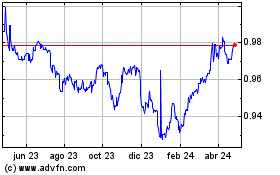Germany Q1 GDP Growth Eases On Weak Trade
24 Mayo 2018 - 2:25AM
RTTF2
Germany's economic growth halved as estimated in the first
quarter on weak trade and government spending, detailed data from
Destatis showed Thursday.
Gross domestic product grew 0.3 percent sequentially, slower
than the 0.6 percent expansion seen in the previous quarter. This
was the weakest growth in more than a year and matched the
provisional estimate published on May 15.
Nonetheless, the economy logged its 15th quarter-on-quarter
growth in a row, contributing to the longest upswing phase since
1991.
The expenditure-side breakdown of GDP showed positive
contribution from domestic demand. Gross fixed capital formation in
machinery and equipment rose 1.2 percent and that in construction
gained 2.1 percent sequentially despite cold weather.
Also, household final consumption expenditure increased slightly
by 0.4 percent. However, government final consumption expenditure
decreased for the first time in almost five years, by 0.5
percent.
On the foreign trade, total exports of goods and services
dropped 1.0 percent and imports decreased 1.1 percent. As a result,
the balance of exports and imports had a downward effect of -0.1
percentage points on economic growth.
On a yearly basis, calendar-adjusted GDP climbed 2.3 percent
after expanding 2.9 percent in the fourth quarter. Similarly,
price-adjusted GDP growth eased to 1.6 percent from 2.3 percent a
quarter ago. The annual rates matched flash estimate.
Once the one-off effects of the first quarter have disappeared,
the German economy should rebound in the coming months and
quarters, Carsten Brzeski, an ING-diba economist said.
However, admittedly, the ongoing slide in confidence indicators,
higher oil prices, Italian politics and the ever-accelerating trade
tensions could delay this rebound, he added.
Elsewhere, survey from the market research group GfK showed that
consumer confidence is set to weaken in June. The forward-looking
consumer sentiment index dropped by 0.1 points to 10.7 in June.
Economic expectations remained the same and income expectations
increased slightly. In contrast, propensity to buy suffered a
downturn in May.
Euro vs CHF (FX:EURCHF)
Gráfica de Divisa
De Mar 2024 a Abr 2024

Euro vs CHF (FX:EURCHF)
Gráfica de Divisa
De Abr 2023 a Abr 2024
